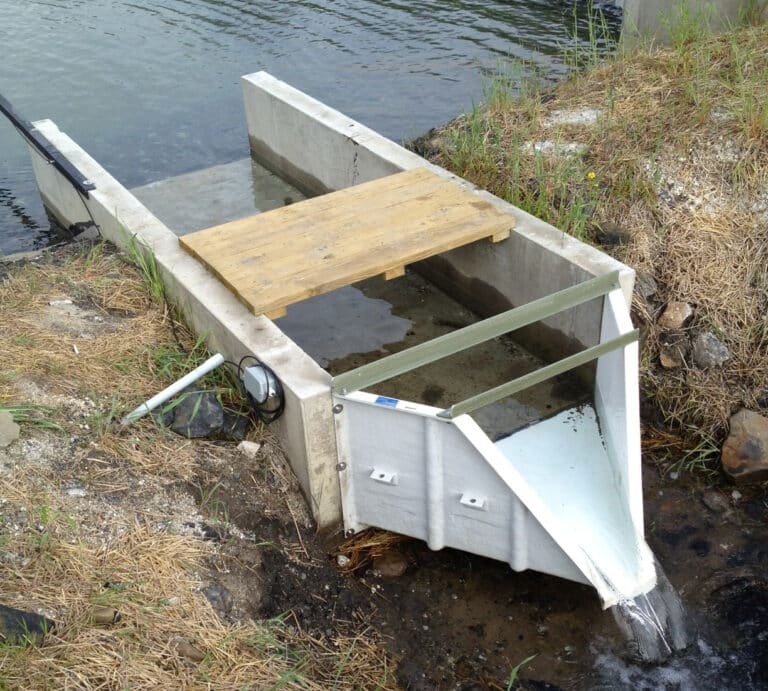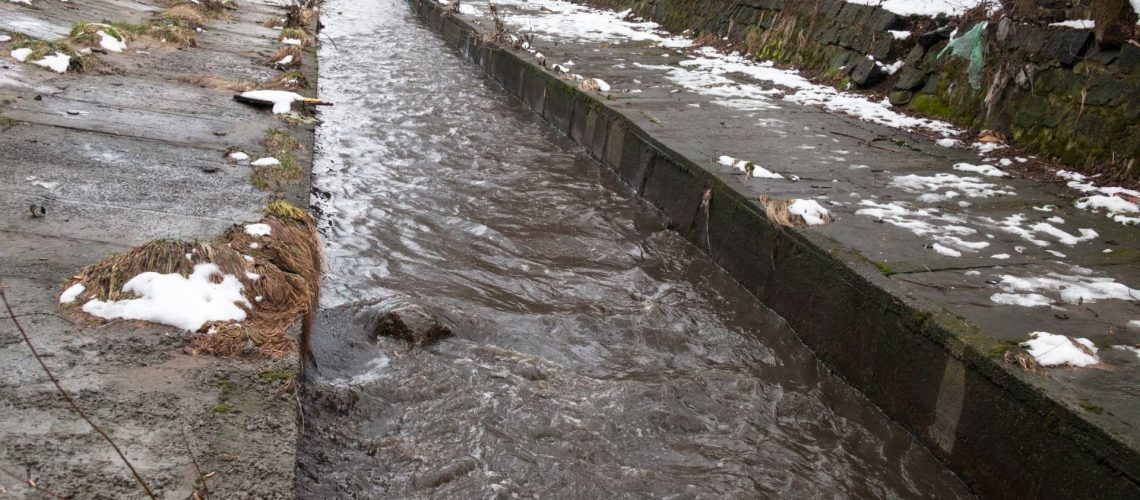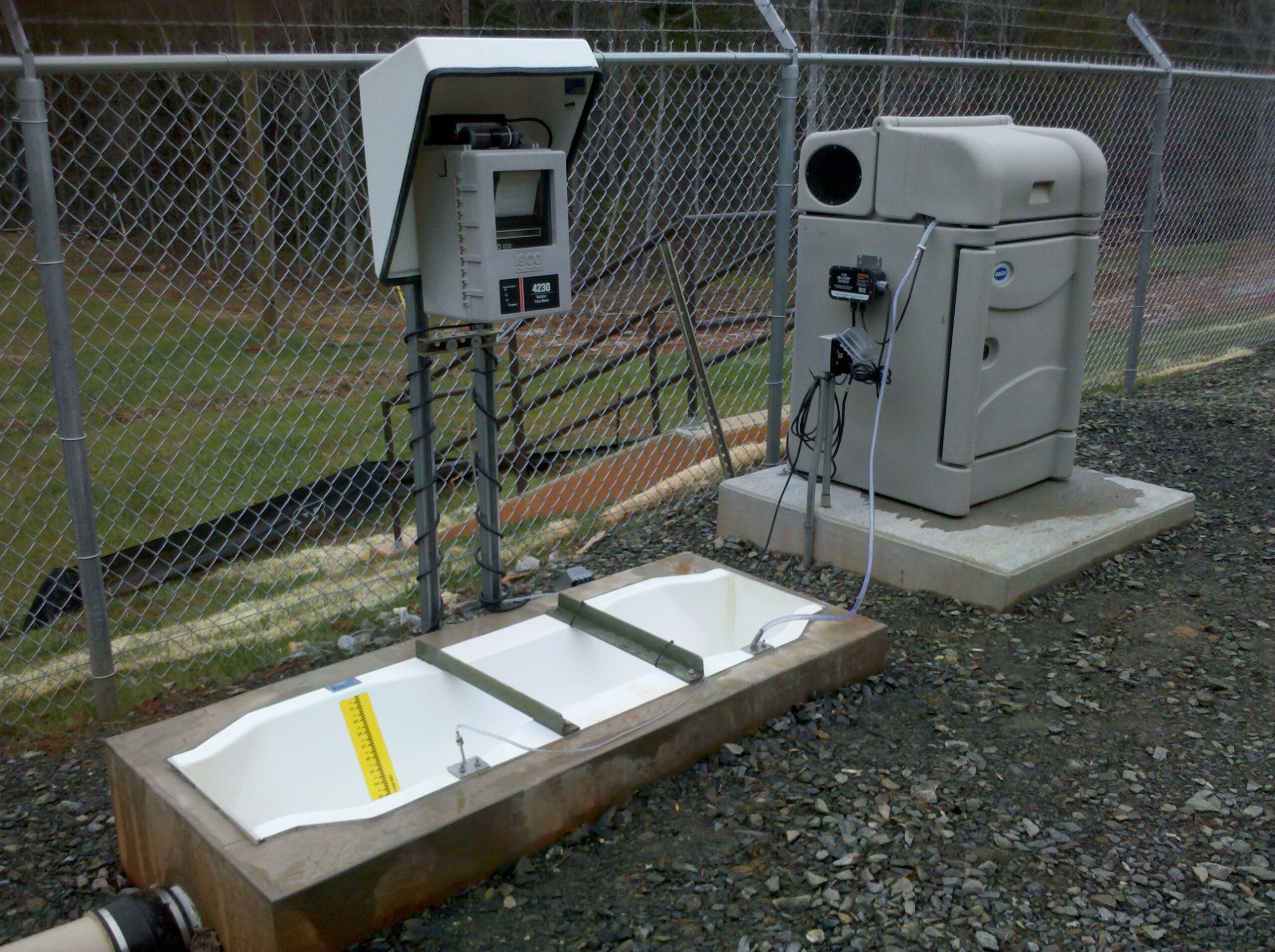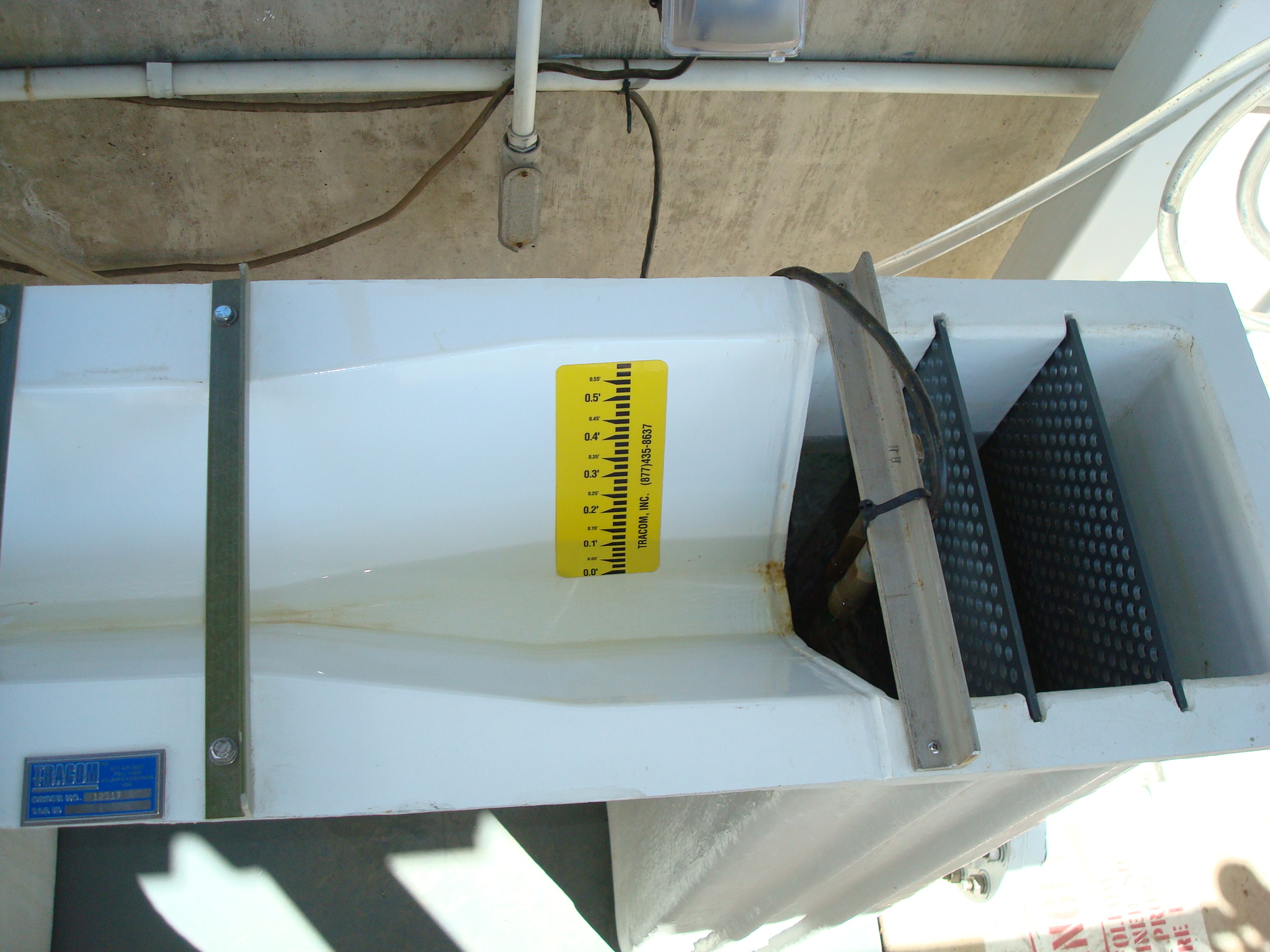Finding the Right Flume for Stormwater Flow
Given the nature of stormwater flows, you’ll need a storm water flume that is capable of handling a wide range of flow rates. Because of this, common options like the Parshall or weir boxes aren’t really suitable for this kind of work. Instead, you’ll need to rely on the less common yet more situationally appropriate H flume and trapezoidal flume design.

H Flumes
The H flume is a uniquely designed flume that functions more like a modified weir than a flume. Think of it like a combination of a flume’s flat floor and self-cleaning capabilities with a weir’s flow sensitivity. This makes it uniquely adept at dealing with stormwater runoff. The throat itself in this flume is V-shaped similar to its cousin the V-notch weir, and it doesn’t use a discharge / diverge section at all. Because of this design, it can handle a wider range of flows than any other kind of flume style on the market today.
One of the key features of an H flume is that it utilizes a flat floor. Because of this, any sediment and smaller bits of debris that come through, such as what floods from storms would bring, pass through pretty easily. Just keep in mind that the smaller sizes of H flumes don’t tend to work that well if larger debris is expected, as the debris can get caught in the narrow throat section.
Trapezoidal Flumes
With the trapezoidal flume, it all began with an effort to measure irrigation flows properly. It was a direct response to the Parshall flume’s inability to properly handle the expected range of flows. In fact, it focuses on low flow sensitivity in its design, which has made them particularly popular when it comes to agricultural applications. With its design, though, it is also exceptionally adept at dealing with stormwater runoff.
Trapezoidal flumes have a flat floor similar to the H flume, and they also have a trapezoidal cross-section designed to merge seamlessly into the natural shapes of irrigation channels like ditches. They come in ten different sizes, so it’s easy to find the one that fits your unique situation the best. Because of their size variation, you can also utilize them in scenarios where you expect some pretty serious debris in the flow. It doesn’t even require free-spilling discharge conditions.
Putting the Flumes to Work
When considering a stormwater flume, it’s time to discover how exactly they function in action. Their design allows them to accurately measure a wide variety of different flow rates, from the rather tame flows at the beginning of storms to the more extreme flows after the rain has been falling for a while. Plus, you don’t have to implement extensive upstream conditioning for them to work properly. In fact, both the Trapezoidal and H-style flumes only need short upstream straight runs to work properly.
While both of these flumes get the job done generally, you’ll still need to find the one that works best for your specific channel conditions. To find the best fit, you’ll need to consider slope above all else. If you don’t have much slope to work with, Trapezoidal flumes tend to be the better fit. This is largely due to the threat of submergence and the H flume’s inability to deal with that. Remember, the H flume requires free-flowing discharge conditions. The Trapezoidal flume, on the other hand, isn’t so strict in that regard.
To add a bit more functionality to your flumes, you may want to consider inlet and outlet connectors if they’re being integrated into conduits or piping. This will make it easier for the flow to pass through properly, ensuring you’re not missing any important aspect of it. Plus, they can allow for a range of meter sensor mounting options to make the actual measuring process just that much easier.
Submergence
Submergence is a major factor you have to keep in mind when selecting a drainage flume. First, though, you need to understand exactly what submergence is. Despite the name, it doesn’t necessarily mean that the entire flume is underwater, though a flume that is underwater would certainly be submerged. Submergence is a state in which the downstream conditions cause the flow to back up in the flume itself. This occurs when the flow is unable to exit the flume without piling up.
The actual point of submergence differs depending on what type of flume you’re using, and this applies to all flumes even beyond the Trapezoidal and H flumes. This point is specifically known as the submergence transition. Its value is represented as a range of percentages, with especially low percentages indicating that submergence is more likely to happen under unfavorable conditions. For reference, the H flume has a submergence transition of 25-30%. Meanwhile, the Trapezoidal flume’s submergence transition is 75-85%.
Drainage Flume Solutions
Flumes are an important part of any drainage system. Drainage flumes can provide effective measurements and control of flow rates to ensure your system is constantly in compliance.With these types of drainage flumes, you can measure a wide range of different flows while dealing with submergence and debris along the way. Every style of flume offers their own unique benefits, so take a moment to consider each before making a decision. That way, you can have confidence in your flume drainage system’s effectiveness.Making Calculations
Dealing with submergence requires you to find the points of measurement. You’re likely already familiar with the primary point of measurement. It’s the point where you take your normal flow readings. The second point, however, is located in or downstream of the throat section, depending on the style of flume you’re working with. Once you’ve found these points, you need to divide the secondary point of measurement by the primary point of measurement. The answer will be the submergence ratio. Just remember that you need to use the same zero elevation for both points. Given that both trapezoidal flumes and H flumes have flat bottoms, though, this should be a given.
When you have the submergence ratio, it’s easy to tell whether or not you’re actually dealing with submerged conditions. If the submergence ratio is greater than the submergence transition, the flume is in fact submerged. If it’s less than the submergence transition, the flume is not submerged. Keep in mind that submergence is much more common in high flow rates, such as what you may find when measuring stormwater runoff. Even so, submergence can occur at any flow rate, such as when there is a blockage downstream.
Accounting for Submergence
If you’re actually dealing with a submerged flume, there are a few solutions you can implement to help ensure that your flume isn’t over-indicating flow rate. Typically, these solutions involve changing the downstream conditions of the flow channel. A modification that allows for free-spilling conditions will certainly decrease the likelihood of submergence. Of course, you can raise the flume too, creating the free-spilling conditions by way of elevation. This is why H flumes are often used as stormwater flow meters in channels that have changes in elevation.
Ideal flumes for flooding: Stormwater Flow Meters
When it comes to measuring flows in areas prone to flooding, stormwater flow meters are often the way to go. Not only are they designed for measuring surface water runoff, but they’re also created with submergence in mind. H flumes allow for more accurate metering but can not operate while submerged. With submergence in mind, flumes like the Trapezoidal flume are a better choice as they have a higher tolerance for submergence.
Controlling the Flow
Submergence isn’t the only problem you may run into with stormwater runoff. Given that storms can make a difference, you’re probably dealing with a flow channel that is open to the sky, though that’s not actually the problem. The threat comes from measuring flows in a natural earthen channel. A creek or a stream can be reliable, but channels aren’t always so easy to define. For ill-defined channels, you have to put in some extra work to make sure the flow goes where it’s meant to.
To capture the flow and make sure it actually goes into your flume without any bypass, nothing helps quite like wing walls. These devices are simple vertical walls that are attached to the upstream edge of the flume’s walls. They’re set up stretching at an outwards angle, forcing the flow to hit the walls and be redirected into the flume itself. All you need to do is make sure that your wing walls are watertight. With that ensured, gravity takes care of the rest.
The Need for Remote Monitoring
Being able to handle a wide range of flows is essential, but you’ll need to take frequent measurements to actually take advantage of all that capability. During severe storms, flow head can actually change quite drastically. This can happen in a matter of hours or even less. Consider setting up some kind of monitoring system that can be operated remotely, so you can take measurements quickly without actually having to travel to the site. After all, you may not even arrive in time to properly measure the effects of the storm.
Flume Materials
To get the proper reliable measurements, you need to make sure that your flume is made out of the right material whether you opt for the trapezoidal or the H flume. While several different materials are available, one tends to stand out among the rest.
Stainless Steel
Known for its long lifespan, stainless steel is an available material among flumes. In fact, it may just have the longest lifespan out of any of the available materials, but that comes with a catch. In order to prolong its lifespan as much as possible, it has to be used exclusively under normal flow conditions. Any kind of variation, such as stormwater runoff with debris, can cause it to wear down quite fast.
Additionally, stainless steel is relatively costly compared to a lot of the other available materials. Given that a normal flow is all that stainless steel is really appropriate for and that other materials naturally handle normal flows well too, utilizing stainless steel is a bit like overkill. It’s not economically viable in most cases, but its inability to withstand the variables of a stormwater runoff flow makes it a poor choice for a trapezoidal or H flume.
Galvanized Steel
While galvanized steel can handle a bit more variety than stainless steel, it can be vulnerable to water impurities. Freshwater flow rates are commonly measured using galvanized steel, and this can even be appropriate for some trapezoidal or H flumes. With freshwater flows, galvanized steel is a reliable and relatively long-lasting material.
While galvanized steel has much to offer as a material, it may not work when it comes to a lot of stormwater runoff flows. This mostly depends on where you find yourself. In a region with a lot of hard water, galvanized steel can corrode quite quickly. The increased flow from storms only makes the hard water more damaging, so you’ll need to consider what kind of water your region has before opting for galvanized steel.
Fiberglass
Fiberglass is a particularly unique material for flumes, with quite a few benefits you may not want to miss out on. It often lasts between 15 to 20 years under normal conditions, so it’s certainly long-lasting. While the abrasiveness of the flow certainly plays a role, fiberglass flumes are equipped with an outer gel coat designed to protect the flume from debris. The gel coat additionally has inherent UV protection, so it can handle the sun just as well as it can handle a storm.
The construction for fiberglass flumes is easy and relatively inexpensive, as they’re crafted from an easily customizable mold in a singular piece in most cases. With its ease of construction and considerable defenses, it’s easy to see why fiberglass might just be the most reliable material available for stormwater flumes.
Trapezoidal and H Flumes from Tracom
To get your hands on trapezoidal flumes or H flumes, you need a reliable manufacturer like Tracom. Not only do we have a vast array of options for you to choose from, but our fiberglass construction methods let you work with our team to design custom flume that uniquely fit your specific flow channel. Contact us today to learn more about how we can help you take control of your stormwater runoff measurement efforts.





